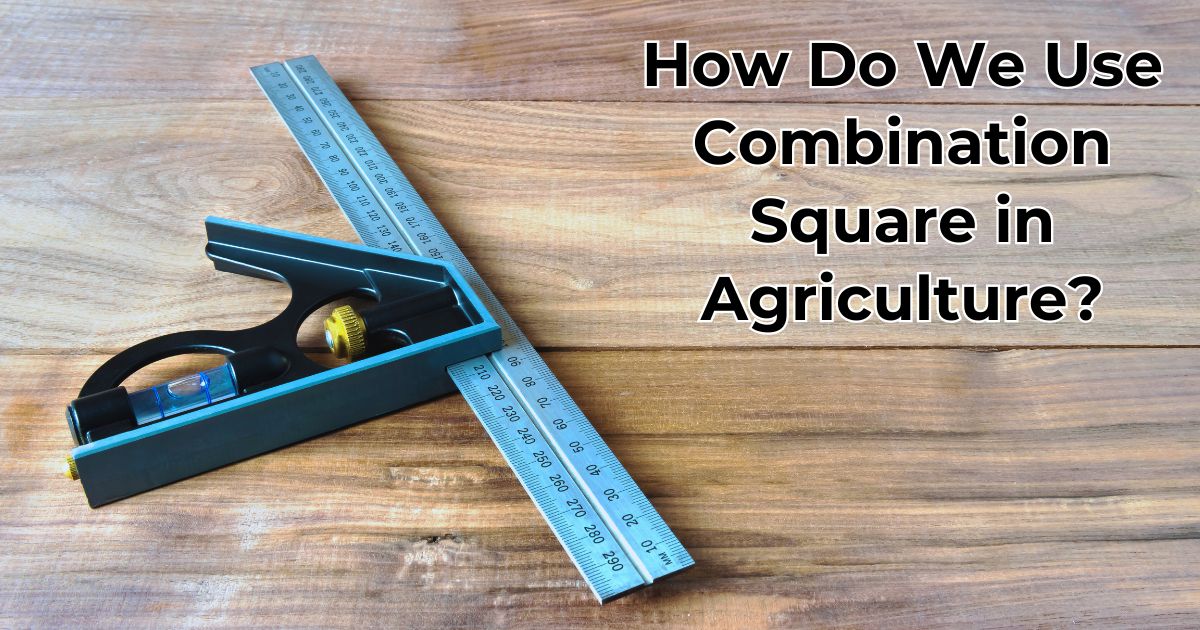Agriculture is a field where precision is paramount. Farmers and agricultural workers strive for accuracy in every aspect of their operations, from planting seeds to constructing structures. One essential tool that aids in this quest for precision is the combination square. This versatile instrument, often found in workshops and construction sites, holds significant value in agricultural settings as well. This article will explore how do we use combination square in agriculture, examining its various applications and benefits, and demonstrating its vital role in ensuring successful farming practices.
Understanding the Combination Square
What Is a Combination Square?
A combination square is a multi-functional measuring tool that consists of a ruler and a movable head, which can be set at various angles. The primary components include a ruler, a 90-degree square, and a level vial, allowing users to measure, mark, and align surfaces accurately. This tool is invaluable for ensuring precise measurements, making it a favorite among carpenters, builders, and farmers alike.
Historical Context and Evolution
The combination square dates back to the 19th century and has evolved over time to incorporate new materials and technologies. Initially made from wood and metal, modern combination squares are often made from durable stainless steel, ensuring longevity and accuracy. Understanding the historical significance of this tool helps farmers appreciate its utility and evolution in their daily tasks.
Importance of Accuracy in Agricultural Practices
Impact on Crop Yield and Quality
In agriculture, accuracy directly impacts crop yield and quality. Even minor measurement errors can lead to uneven planting, improper spacing, and inefficient resource use. Utilizing a combination square helps farmers maintain the correct dimensions in their operations, ensuring that crops receive the appropriate amounts of sunlight, nutrients, and water for optimal growth.
Role in Farm Management
Effective farm management relies on precision. Farmers must measure distances, angles, and levels accurately to ensure their fields and structures are correctly aligned. A combination square allows for easy adjustments and corrections, fostering a more organized and productive farming environment. By understanding the significance of accurate measurements, farmers can make informed decisions that ultimately enhance their operations.
Measuring Angles for Land Layout
How to Measure Angles with a Combination Square
One of the primary functions of a combination square is measuring angles. Farmers can use the square to create precise right angles when laying out fields or constructing structures. By positioning the square against a reference line, farmers can mark 90-degree angles, ensuring that rows are straight and Baddiehub.
Case Study: Optimizing Row Spacing
Proper row spacing is crucial for crop growth. For example, when planting corn, farmers must maintain a specific distance between rows to ensure adequate sunlight and airflow. By using a combination square to measure and mark these distances, farmers can optimize their planting layouts, leading to healthier plants and higher yields. A well-planned layout also simplifies irrigation and pest control, enhancing overall farm efficiency.
Leveling Techniques Using a Combination Square
Step-by-Step Guide on Using the Level Vial
The combination square features a built-in level vial that can be used to ensure surfaces are level. To use this feature, farmers should place the square on the surface they want to check. If the bubble in the level vial is centered, the surface is level. If not, adjustments can be made accordingly. This simple yet effective technique is essential for constructing structures like barns or greenhouses.
Importance of Leveling in Construction and Planting
Leveling is critical in agriculture, particularly when establishing foundations for buildings or laying out irrigation systems. Uneven surfaces can lead to water pooling or erosion, negatively impacting crop growth and soil quality. By employing a combination square to achieve level surfaces, farmers can enhance the durability of structures and promote better water management practices.
Marking Measurements for Planting
Using the Ruler Component for Accurate Measurements
The ruler component of the combination square allows for precise measurements to be marked directly on the ground or planting medium. Farmers can measure distances between seeds, plants, or rows with ease. This accuracy ensures that crops are planted at optimal distances, preventing overcrowding and ensuring each plant has enough space to grow. So, how do we use the combination square in agriculture? This tool is invaluable for achieving uniform spacing and alignment in planting.
Best Practices for Marking Distances in Planting
When marking measurements for planting, farmers should establish a consistent methodology. For example, they can use the combination square to mark the first row, then use a tape measure to ensure uniform distances between subsequent rows. Consistent marking not only enhances crop growth but also simplifies maintenance tasks, such as weeding and harvesting.
Checking Squareness in Construction
Importance of Squareness in Building and Repairs
Ensuring that corners are square is vital in agricultural construction and repairs. A square structure is not only aesthetically pleasing but also more stable and durable. Using a combination square to check for squareness helps prevent issues such as structural failure or misalignment in future projects.
Step-by-Step Process for Checking Corners
To check for squareness using a combination square, farmers should place the square against the corner and align it with both adjacent walls. If both walls touch the square evenly, the corner is square. If there are gaps, adjustments can be made to ensure the structure is properly aligned. This process is essential when constructing fences, animal enclosures, or storage sheds.
Layout and Alignment for Optimal Efficiency
How to Lay Out Plots and Fields with Precision
A well-organized farm layout promotes efficiency and productivity. Farmers can use a combination square to establish clear boundaries for plots and fields. By measuring and marking the dimensions accurately, they can create a layout that facilitates effective irrigation, pest control, and harvesting.
Aligning Rows and Borders for Better Organization
Proper alignment of rows and borders ensures that crops receive equal access to sunlight and nutrients. Farmers can use the combination square to create straight lines, which not only enhance the visual appeal of the farm but also simplify maintenance tasks. A well-organized field layout can significantly improve workflow, making it easier to manage daily operations.
Maintenance Tasks with a Combination Square
Common Maintenance Tasks That Require Precision
Agricultural equipment and structures require regular maintenance to operate effectively. Tasks such as adjusting machinery, repairing fences, or building new structures demand precise measurements. The combination square can assist in these tasks, ensuring that adjustments are made accurately, prolonging the lifespan of equipment and structures.
Using a Combination Square for Equipment Alignment and Adjustments
When aligning machinery components, farmers can utilize the combination square to ensure that parts are positioned correctly. For example, when adjusting a plow or tractor, using the square helps verify that everything is aligned, promoting efficient operation and reducing wear and tear. Regular maintenance checks with a combination square can prevent costly repairs and downtime.
Cost-Effectiveness of Using a Combination Square
Comparison with Other Measuring Tools
While there are various measuring tools available, the combination square stands out due to its versatility and ease of use. Unlike specialized tools that may serve a single purpose, the combination square can measure angles, levels, and distances, making it a cost-effective solution for farmers. Investing in a quality combination square often yields a better return on investment compared to purchasing multiple specialized tools.
Long-Term Benefits of Accurate Measurements on Farm Productivity
Accurate measurements contribute significantly to long-term farm productivity. By utilizing a combination square, farmers can minimize errors that lead to wasted resources, such as seeds, water, and fertilizers. This efficiency not only enhances crop yields but also reduces operational costs, ultimately improving the farm’s bottom line.
Conclusion
In conclusion, how do we use combination square in agriculture? The combination square is an indispensable tool in agriculture, offering precision and versatility that enhance farming practices. From measuring angles to ensuring level surfaces, this tool plays a crucial role in maintaining the accuracy required for successful operations. By incorporating a combination square into daily tasks, farmers can optimize their workflows, improve crop yields, and enhance the overall efficiency of their agricultural practices. As the agricultural landscape continues to evolve, embracing precision tools like the combination square will remain vital for achieving sustainable and productive farming.









